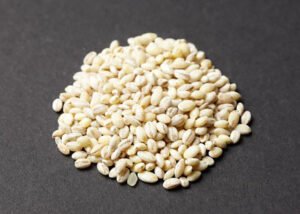BARLEY

Wholegrains provide a wide variety of health benefits, including for heart health. The Heart Foundation (Australia) says eating wholegrains can reduce the risk of heart disease and replacing refined grains with wholegrains can improve heart health. While fruits and vegetables attract a lot of good press for disease prevention, wholegrains can hold their (seed) heads high in this regard. Eating 2-4 serves of wholegrains a day can reduce the risk of coronary heart disease by up to 40%. They have a combination of heart-friendly nutrients including dietary fibre and phytonutrients that help manage blood cholesterol and satisfy appetite. They also have preventive power for type 2 diabetes.
Barley (Hordeum vulgare) is a less often consumed wholegrain that really should get higher rotation on our menus. Barley is rich in a type of soluble fibre called beta-glucan that helps lower blood cholesterol. Barley also has a low Glycemic Index (GI 30) so its great for people wanting to manage their blood glucose levels.
Barley is the 4th most common grain in the world, after wheat, rice and corn. So how can this be when many of us eat very little? The reason is most is used for animal feed, and a lot is used for brewing (to make malt for beer). Keeping a bit more barley for us to eat would help benefit our health. It is also an adaptable crop that will grow in a range of climates and that is good news in the face of global climate change.
You can purchase barley hulled or pearled, rolled into flakes or as barley flour. While only unhulled barley is truly whole grain, it’s hard to find (try online), requires pre-soaking, takes longer to cook, and is very chewy to eat. However, even the most common pearled (polished) barley is loaded with fibre, is highly nutritious and much nicer to eat. The barrier to eating more barley may be not knowing how to cook it, but it couldn’t be easier. Just boil until plump and tender (1 part barley to 3 parts water), and this usually takes 25-30 minutes for pearl barley. There is no need to pre-soak. Barley triples in volume when cooked. Try making large quantities when you have time and then freezing meal-sized portions for a later.
Use cooked barley as you might rice or pasta, as a side dish or in a ‘bowl’ meal, in a salad, or in soups, stews and casseroles. You could use barley flour in baking, although without gluten it doesn’t produce light and spongy texture and requires recipes specifically developed for barley. You can even make barley porridge; delicious served with fruit and nuts. There are plenty of recipes online to explore.
Food industry has helped make barley more available by providing a range of foods containing barley such as breads, cereal bars and breakfast cereals. There has been scientific innovation on the grain itself by the Australian CSIRO (Commonwealth Scientific & Industrial Research Organisation) in creating (non-GMO) Barley Plus®, a variety of barley with a beneficial combination of soluble fibre, insoluble fibre and resistant starch that provides gut health benefits. This ingredient is now available in a range of breakfast cereals in Australasia.
I’ve ‘barley’ touched the surface of the potential of this healthy grain (geddit?), so add barley to your next shopping list and experiment with something new or adapt an old favourite recipe.
| Pearl Barley | |
| 5 Health Stars | |
| Glycemic index | 30 |
| Serving size – ½ Cup (95 g or 3.3 oz), cooked | |
| Kilojoules | 560 |
| Calories | 135 |
| Protein (g) | 4.0 |
| Fats (g) – total | 1.0 |
| Includes: – Saturated fat (g) | 0.2 |
| – Monounsaturated fat (g) | 0.2 |
| – Polyunsaturated fat (g) | 0.6 |
| Saturated : unsaturated fat ratio | 0.25 |
| Carbohydrates (g) – Total | 29.1 |
| Available (Includes): | 23.9 |
| –Natural sugars (g) | 0.4 |
| –Natural starches (g) | 23.5 |
| –Added sugars (g) | 0.0 |
| –Added starches (g) | 0.0 |
| Unavailable (Includes): | 5.2 |
| –Dietary fibre (g) | 5.2 |
| Sodium (mg) | 9 |
| Glycemic load (g) | 7 |
| Diabetes exchanges | 1.5 |
| Ingredients: Barley |








